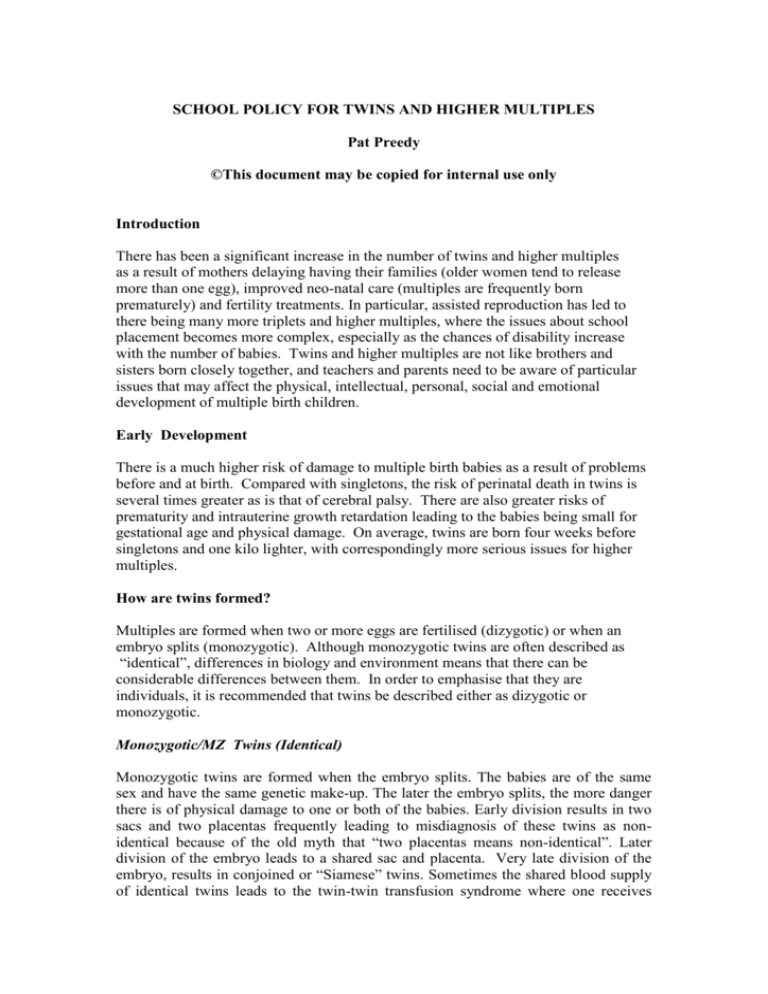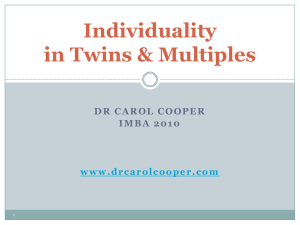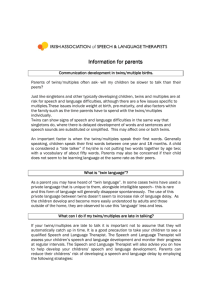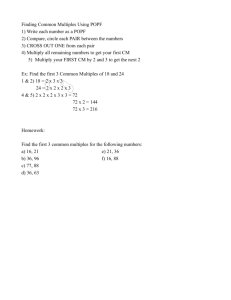Document 8513731
advertisement

SCHOOL POLICY FOR TWINS AND HIGHER MULTIPLES Pat Preedy ©This document may be copied for internal use only Introduction There has been a significant increase in the number of twins and higher multiples as a result of mothers delaying having their families (older women tend to release more than one egg), improved neo-natal care (multiples are frequently born prematurely) and fertility treatments. In particular, assisted reproduction has led to there being many more triplets and higher multiples, where the issues about school placement becomes more complex, especially as the chances of disability increase with the number of babies. Twins and higher multiples are not like brothers and sisters born closely together, and teachers and parents need to be aware of particular issues that may affect the physical, intellectual, personal, social and emotional development of multiple birth children. Early Development There is a much higher risk of damage to multiple birth babies as a result of problems before and at birth. Compared with singletons, the risk of perinatal death in twins is several times greater as is that of cerebral palsy. There are also greater risks of prematurity and intrauterine growth retardation leading to the babies being small for gestational age and physical damage. On average, twins are born four weeks before singletons and one kilo lighter, with correspondingly more serious issues for higher multiples. How are twins formed? Multiples are formed when two or more eggs are fertilised (dizygotic) or when an embryo splits (monozygotic). Although monozygotic twins are often described as “identical”, differences in biology and environment means that there can be considerable differences between them. In order to emphasise that they are individuals, it is recommended that twins be described either as dizygotic or monozygotic. Monozygotic/MZ Twins (Identical) Monozygotic twins are formed when the embryo splits. The babies are of the same sex and have the same genetic make-up. The later the embryo splits, the more danger there is of physical damage to one or both of the babies. Early division results in two sacs and two placentas frequently leading to misdiagnosis of these twins as nonidentical because of the old myth that “two placentas means non-identical”. Later division of the embryo leads to a shared sac and placenta. Very late division of the embryo, results in conjoined or “Siamese” twins. Sometimes the shared blood supply of identical twins leads to the twin-twin transfusion syndrome where one receives most of the nutrition and is engorged whilst the other is pale and sometimes 500g or more smaller. Twin-twin transfusion syndrome can mean that identical twins seem less alike than non-identical twins. Also, not all characteristics are genetic accounting for further differences between MZ twins. Di-zygotic/DZ Twins (Non-Identical) Dizygotic twins are produced when two individual eggs are fertilised by two different sperm. These twins are no more alike than brothers or sisters. They may be same sex boy twins, same sex girl twins or boy/girl twins. The placentas of DZ twins may fuse together with the result that many have been incorrectly diagnosed as MZ (identical) twins. Unlike MZ twins, the release and fertilization of two eggs can vary with maternal age, with assisted reproduction and with ethnicity, DZ twins being more common in mothers of African ancestry and less common in ones from Asia. Higher Multiples (33 weeks gestation is normal for triplets) Triplets and higher multiples may result when individual eggs are fertilised by individual sperm, as in the case of DZ twins, or when the embryo splits as in the case of MZ twins. The risk of physical disability is greatly increased with the number of babies present Delayed School Entry Many multiple birth children are born prematurely. Even when there are no actual disabilities resulting from prematurity and low birthweight, the real date of birth may be extremely important. Premature children may be forced into the school year above their “correct” year if they are born two or three months early, as can happen with multiples. This may result in the children being assessed as behind their peers, when in reality they are being compared with an older age group. When assessing premature children, it may be helpful to compare them with the year group below, to see if their development and performance is more in line with this year group. Parents and educators may consider applying for delayed school entry, or for additional time in the early years setting in order to allow such children further time to develop. A more difficult situation arises if one multiple is significantly delayed compared with the peer group. The question arises, “Should the other(s) start school or be advanced whilst one stays behind?” Professional assessment is required in order to decide upon appropriate intervention, which may or may not include delaying school entry. Intellectual Development On average, multiple birth children score lower on IQ tests and tests of language ability. However, this allows for many to do as well, if not better, than their singleton peers and multiples should therefore not be stereotyped. Lower scores have been attributed to the unique environment of multiple birth children where they receive fewer interactions and adult models than singletons. If left together for long periods they may re-enforce each others’ immature speech. This special twin language is sometimes referred to as cryptophasia or idiologlossia. It is recommended that schools assess the language of development of multiples and not dismiss delay or disorder as something they will grow out of, or as being typical of multiples. An individual education plan (for each child) needs to detail appropriate intervention which may involve liaising with speech and language therapists. The Performance Indicators In Primary Schools (PIPS), devised by Professor Peter Tymms from the University of Durham in the UK, measure the starting point and then the comparative (value added) progress of children in Maths and reading. Data from the PIPs demonstrate modest differences between multiple birth children and singletons. However, these are general trends using a large sample, whereas teachers are concerned with the learning and progress of the individual. Each child needs to be assessed as an individual so that if required, learning support can be provided according to need. If both children have special needs the support should not be halved as though they were one person. Our Australian work indicates that there may be a greater tendency for multiple birth children (especially boys) to have higher incidences of Attention Deficit Hyperactivity Disorder (ADHD). Such children may be impulsive and have difficulty concentrating and staying on task. Care must be taken when assessing the behaviour of young children. They are naturally lively and curious and assessments need to take into consideration child development and learning through play. Routines, clear rules and self-organisation strategies such as “plan, do and review” may help children to focus on the learning required. Children may also find it helpful to picture a dial to control their behaviour. For example, ten may be very active, 5 may be just right for learning, one may be just right for sleep. Adjusting the dial helps the child to adapt his/her own behaviour to the particular context – the football field is different from the library! Personal, Social and Emotional Development Multiple birth children are not able to develop personally, socially and emotionally in the same way as singletons. There is always the co-multiple(s) present for direct comparison and competition. Although siblings are compared, and rival each other trying to establish dominance, the relationship may be more intense for multiples. Comparison It is part of human nature to make comparisons and although siblings may be compared by parents, friends, teachers and others, for multiple birth children direct comparisons can be made from birth without the “excuse” that one of the children is considerably younger or older. If one multiple birth child is always compared to the detriment of the other, he or she may lose self-esteem and opt out. The children themselves may become over concerned with comparing themselves, looking for differences to indicate that one is better than the other: Both adults and children need to consider the positive aspects of each child. This may be difficult if one child always seems to achieve more. If one receives an award and the other doesn’t, it can be hard to reward one whilst consoling the other. However, if the children are placed in context with their peers, a bigger picture may help to understand that comparison is not just with one’s co-multiple(s). Teachers need to emphasise the uniqueness of each child. When speaking about a twin or higher multiple to other staff or to parents, this child needs to be discussed relative to the peer group and not just to the other multiple(s). Parent/Teacher consultations need to be arranged so that each child is discussed separately. The time allocated for each multiple needs to be the same as for singletons in the peer group. Consideration may also have to be give as to how the children operate as multiples e.g they may be highly competitive at home. Competition and Rivalry For multiple birth children rivalry may be more intense than with singletons. The children may become highly competitive, having a heightened sense of what is fair, frequently demanding exactly the same. Even if multiple birth children are in the same class at school, they can not always be treated the same. Teachers may not always fully understand if one twin becomes upset if they perceive the other to be having a better deal. If one comes “first” and the other “second” in the class or school, then one is inevitably considered less able by the others. Multiples may need help to understand that life is not fair and that they can not always be treated in the same way or have the same. Teachers and parents can help by praising each child for their achievements and helping multiple birth children to be pleased when their comultiple has success. Dominance Dominance may take the following forms: Neither child dominates One always dominates The children alternate dominance Dominance varies according to the situation or activity Although one child may dominate in the home situation, this may not be the case particularly when the children start school. Observation of the children, particularly in a play situation, may help to determine which child, if any, is dominant, the nature of the dominance and whether this appears to be adversely affecting their learning. Where one child is always dominant, even speaking for the other, the dependent child may find it difficult to function effectively in school. However, when separated it may be the dominant child who loses confidence and the dependent child who blossoms and gains in confidence. If one child is always dominant, try arranging play sessions with children where the children do not have their co-multiple(s) present. Playing with younger children may help the dependent child to assume a leadership role. Playing with older children may help the dominant child to take orders. Individuality and Self Image Central to personal, social and emotional development is an awareness and understanding of self, with the development of a positive self- image. By school age children place themselves in categories such as age, size and gender, referring to qualities and characteristics as well as to appearance. However, for multiple birth children, there is the additional category of “twin”, “triplet” or more. Their concept of self and their development as individuals, is inextricably linked with how far they and others perceive them to be a unit. Some multiple birth children are so dependent on each other that they are unable to function as individuals. The nature of the multiple birth relationship may be so close that the death of a multiple is particularly painful for the surviving twin. The relationship between multiple birth children varies from those who seem distinct, independent individuals to those who only seem to be able to function as a couple or unit. We describe the following three main multiple “types”: “Closely Coupled” “Mature Dependents” Multiple birth children who act as though they are a couple or unit and are mostly treated by other people as one unit. The children may respond to both names interchangeably and be unable to recognise their own mirror image. They have few or no friends outside of their twinship and may combine to be a powerful unit. These are multiple birth children who enjoy their relationship with each other functioning effectively both as multiples and as individuals. They are able to pursue their own interests and friendships without resenting or over-competing with their co-multiple(s). If they happen to have the same interest or talents as their co-multiple(s) they still pursue that course aware that being an individual sometimes means doing the same as your co-multiple(s). “Extreme Individuals” Multiple birth children who find their relationship with each other restrictive to such a degree that they may fight, deny their multiple birth relationship sometimes polarizing to opposite extremes in order to establish their own identities. The following model may be used to assess how multiple birth children operate as multiples and as individuals. The characteristics displayed by each child are recorded by ticking the box next to each descriptor. A box is ticked on the horizontal line every time an indicator is identified. Ticking the horizontal line enables the complexities of the multiple birth relationship to begin to appear. Children may fall broadly into one of the three types or they may swing from being intense individuals to being closely coupled or they may display characteristics of all three. The children within the multiple sets may vary, for example, one child may be “Closely Coupled” whilst the other is a “Mature Dependent”. Life experiences and comparison underpin the model as these constantly apply. Model Of The Personal Social And Emotional Development Of Multiple Birth Children (© May be copied for internal use) Extreme Individual Mature Dependent Closely Coupled Name Name Extreme Individual Plays mostly alone Likes own friends – doesn’t share friends opts out if twin successful polarises – goes to extremes (angel/devil) excessively competitive dislikes co-multiple(s) refuses to dress alike tries to dominate Name Name Mature Dependent shared and separate friends happy separated and happy together supportive of co-multiple(s) has developed as an individual with own identity Can choose same or different from co-multiple(s) Name Name Closely Coupled Name unhappy when separated – want to be together most/all of the time respond to each others’ names/ group name e.g Twinnie can not recognise mirror image uses twin “language” (cryptophasia) slows down/speeds up to keep together especially in school few or no individual friends combines to form a unit dress and behave identically Life Experiences/ Comparison Preedy (2001) Name Separation In School Putting multiple birth children into separate classes requires careful consideration and consultation with parents. Most multiple birth children have little experience of separation prior to starting school. They may be upset if they have to cope with a dual separation from parents and their co-multiple(s). Many schools have policies (written and unwritten) declaring that multiples should be separated in order to help them to develop as individuals or should be kept together as multiples are a natural unit. Some schools have rigid organisational policies that fail to take into account the needs of multiples e.g classes are arranged in alphabetical order or birthdate so multiples have to be kept together. There is no right or wrong answer with regard to separation in school. The needs of each child must be considered both as an individual and as a multiple. No decision should be irreversible – flexibility is the key word both for parents and teachers. Advantages of separation in school The children are able to operate as individuals within the class situation. The teacher is more likely to compare the multiple child against the peer group instead of his or her co-multiple(s) The multiple birth child is able to operate without his or her co-multiple telling particularly if he or she is in trouble The multiple birth child has an opportunity to make friends and socialise as an individual Disadvantages of separation in school Multiple birth children may need the support of each other particularly if they have not experienced separation prior to school Even if multiple birth children are comfortable when separated, they may need to be able to check up on what the other is doing If one child is dominant the dominant child may lose confidence as he or she no longer has his or her co-multiple(s) to organise The children may compared more at home particularly if one appears to be making more progress e.g. gets a reading book first The teachers are less likely to understand how the children operate as multiples e.g. being upset if one is ill or in trouble If the children have experienced a recent trauma, such as bereavement, they may need the support of their twin in class. Parents and teachers need to discuss how they will support the children before reversing a decision too quickly. Multiple birth children are likely to benefit from separation when : one child is markedly more able than the other one child perceives himself or herself as failing there is markedly similar progress with one child leveling up or down so that they can keep together there is disruptive behaviour where multiples form a “fatal combination” one or both children are dependent unable to mix or relate with other children there is intense competitiveness so that the child’s main goal is to keep up with or beat their co-multiple(s) one or both children polarise (go to opposite extremes) there is lack of privacy where one multiple birth child constantly reports to parents about the activities and progress of the other Before deciding whether to separate multiple birth children, parents and professionals should meet to discuss the pre-school development and experiences of the children. The questionnaire in the Preschool section provides a useful framework for assessing the children both as individuals and as multiples, prompting discussion about how best to support the learning of the children. Conclusion Having decided to include the needs of multiple birth children in school policy, schools may wish to consider what sort of school they wish to become: Extreme Individualising Schools Multiple birth children are always separated as it is believed that this will help the children to develop as individuals. Flexible Schools The school is aware of the potential needs of multiple birth children and their families. Closely Coupling Schools Multiple birth children are always kept together as it is believed that they are a natural unit. Schools may not: Schools may not: acknowledge the multiple relationship and the possible need for the children to be near each other or to be able to check out what the other is doing take into account that one child may be affected by the other e.g. by being extremely competitive or by opting out support the children personally, socially and emotionally in order to develop as individuals Parents and children’s views with regard to separation are taken into consideration. The children are assessed to consider whether separation is appropriate when they start school. Arrangements can be changed according to the needs of the children. The multiple birth relationship is acknowledged and celebrated as well as enabling children to develop as individuals. The children are recognised and called by name. Individual achievements are recognised and celebrated The children are comfortable selecting the same or similar subjects/activities understanding that being an individual may mean doing the same recognise individuals call individuals by name assess the children separately report on their progress separately recognise individual problems and issues provide for multiple birth children as individuals e.g. when one has a special need Although some smaller schools schools do not have the option of separating multiple birth children into separate classes, they may be assessed according to the categories in the table. Children may be placed in separate groups, rather than separate classes and staff attitude to multiple birth children may also be assessed. For example, if staff are unable to identify multiple birth children and call them by name, they may be treating the children as a unit rather than as individuals. Rather than simply considering whether schools have enough classes for separation, parents may wish to visit prospective schools in order to decide which “type” the school appears to be and whether it is likely to meet the needs of their multiple birth children. Schools considering how to meet the needs of multiple birth children may also first wish to consider what sort of school they would like to be as measured against the descriptors in the table. When entering nursery/kindergarden or school, multiple birth children may need special consideration. They should not be labeled as taking up more than one place. They may particularly need a pre-school place as they have may have had little or no opportunity to socialise with other children, and to make friends on an individual basis. Being a multiple birth child is not a disability. The following are some of the advantages of being a multiple: a unique and special relationship that is not available to singletons an understanding about sharing and waiting for adult attention right from the start having a companion and friend available particularly when tackling homework and revision for exams. having a competitor who can spur you on to do better Multiples are special people who often receive special attention. As long as this does not go to extremes and the children develop as mature ‘dependents’ comfortable both as multiples and as individuals, there is no problem. With understanding and support where necessary, multiple birth children can make good progress in school enjoying and celebrating the fact that they are a multiple.







